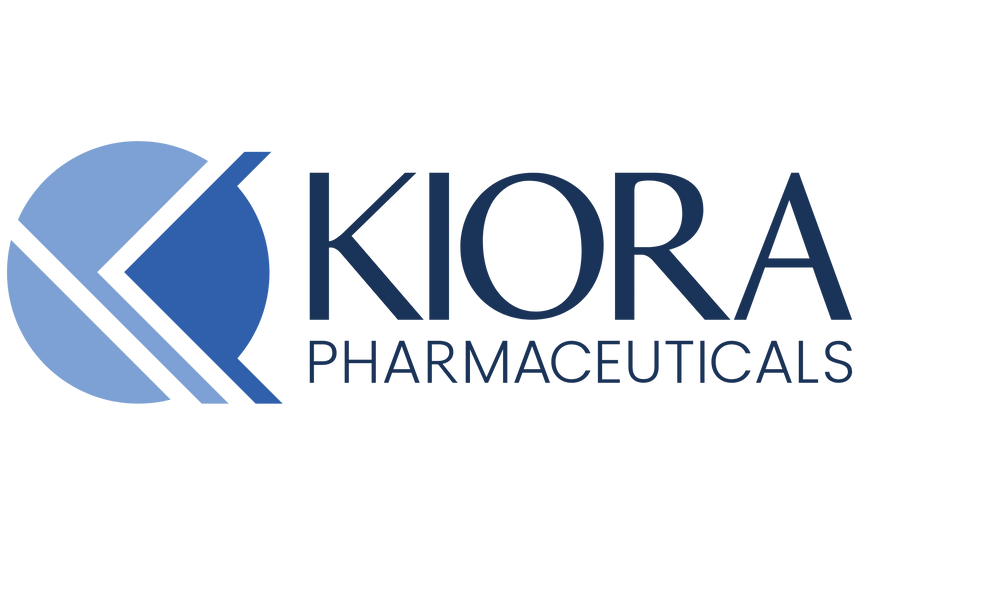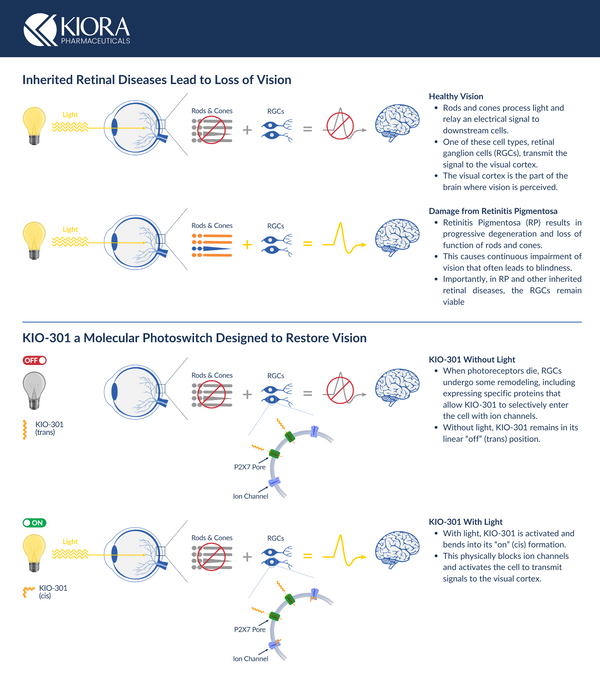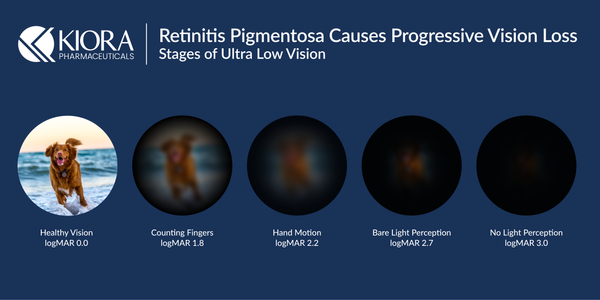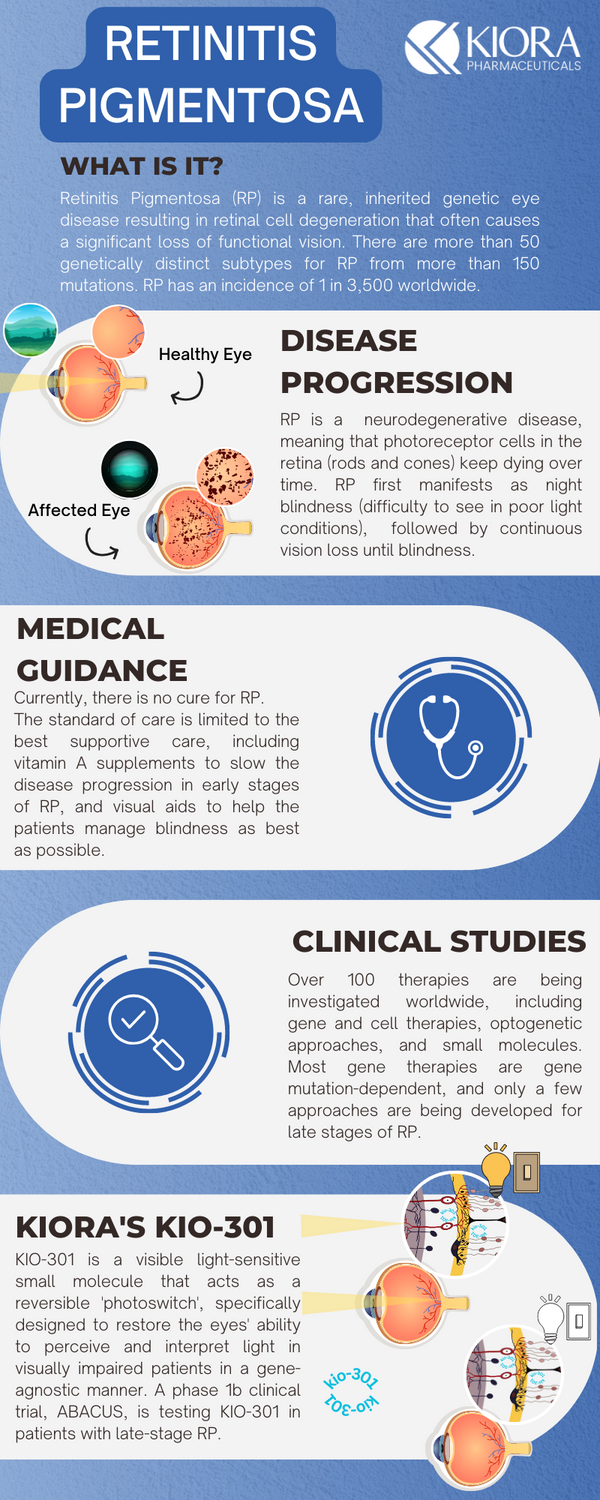ENCINITAS, CALIF., November 4, 2023 – Kiora Pharmaceuticals (NASDAQ: KPRX) today announced topline results of a Phase I/II clinical trial demonstrating proof-of-concept that KIO-301, the company’s first-in-class small molecule, has the potential to meaningfully improve vision in patients with Retinitis Pigmentosa (RP) who are living with ultra-low vision or complete blindness. The ABACUS study is a first-in-human, open-label, multi-site, single dose-escalating clinical trial for Kiora’s intravitreal (IVT) molecular photoswitch. The results were presented as a late-breaking presentation at the American Academy of Ophthalmology annual conference (AAO 2023) during the Retina Subspecialty Day by Russell N. Van Gelder, MD, Ph.D., Professor and Chair, Department of Ophthalmology, University of Washington, School of Medicine.
Although the study was not powered to primarily assess efficacy, the following topline observations were reported in line with proof-of-concept for this novel class of light-restoring small molecules:
- Kinetic visual field (Goldmann perimetry) increased significantly from baseline at days 7 and 14 post treatment (p < 0.05).
- Mean improvement in visual acuity, as measured using the Berkeley Rudimentary Vision Test, of 0.30 logMAR (equivalent to 3 lines of visual acuity) in the high dose group (p=NS).
- Light perception, as assessed using an unprompted, binomial, back-projected letter display, improved from baseline (Odds Ratio 2.1-4.2; 0.23-41.80 [80% CL]; p=NS) in patients with no or bare light perception.
- The percentage of successful navigation in the Ora-MLOM™ (Multiluminance Orientation & Mobility) High Contrast Room Exit, a test of mobility and functional vision under controlled lighting, trended toward improvement from 24.7 ± 15.2% at baseline to 60.0 ± 20.7% at day 28 (p=NS).
- Functional MRI demonstrated a qualitative increase in brain activity in the primary visual cortex at days 2 and 14 post-injection compared to baseline.
- Patient-reported positive impact on overall functional vision as it relates to the use of sight in everyday activities.
- Improvement in quality of life, as measured by the National Eye Institute Visual Functional Questionnaire. There was an increase of 3.3 points (an increase of 2-4 points is considered clinically meaningful1).
- The duration of effect appears consistent with preclinical pharmacokinetic data, supportive of formulation as a monthly IVT injection.
- KIO-301 is safe and well tolerated with no ocular and non-ocular serious adverse events, nor any signs of retinal inflammation.
In addition to the objective data, patients reported positive changes in their vision over the course of the 28-day study. "I have been blind and living in complete darkness for over 10 years and was resigned to never seeing again. During my time on this trial, under the care of Dr. Robert Casson and his team, it has changed that reality, and in fact gave me the ability to once again see light for about a month,” said Chris Edwards, a trial participant. “I look forward to future clinical trials and hope this therapeutic may eventually help all of those in need.”
Under the direction of Co-Principal Investigators, Drs. Casson (University of Adelaide, Department of Ophthalmology) and Van Gelder, the ABACUS trial included 6 patients who were administered KIO-301 in each eye for a total of 12 eyes assessed. Half of the patients enrolled were the most severely affected by RP, having either no ability to perceive light (no light perception), or barely perceive light. The remaining three were able to perceive light but live with ultra-low vision, clinically diagnosed as being able to perceive hand motion or count fingers, but incapable of reading even the largest letter on an eye chart. Each eye received a single IVT injection of either 7.5 (n=3), 25 (n=6), or 50 µg (n=3) of KIO-301. Assessments were performed at baseline (prior to KIO-301 injection) and several timepoints over 28 days post-treatment. While safety/tolerability was the primary endpoint of the trial, visual acuity, kinetic visual field, and functional vision changes were also assessed. To understand if activity within the visual cortex of the brain changed due to treatment, functional MRI was also included in the trial.
“This new technology offers hope to patients living with late stage inherited retinal diseases. The mechanism of action and trial data firmly support KIO-301’s continued development, potentially filling a major unmet need in the search for treatments for these patients,” said Dr. Van Gelder. “Based on shared pathology between RP and other inherited retinal diseases, we believe there is an opportunity to explore KIO-301 for several other indications including choroideremia and Stargardt’s disease.”
KIO-301 is a small molecule, referred to as a molecular photoswitch, potentially conferring light-sensing capabilities to special types of retinal neurons called Retinal Ganglion Cells (RGCs). In healthy eyes, light detection is performed by photoreceptors (rods and cones). In RP, mutations in any of 150 known genes lead to eventual death of photoreceptors, typically starting in the teenage years. This photoreceptor death first results in difficulty seeing in dark environments, progressing to a narrowing of one’s field of vision, and eventually leading to complete blindness. The death of photoreceptors allows KIO-301 to selectively enter RGCs. Once inside the cell, KIO-301 localizes within specific voltage-gated ion channels involved in regulating neural signaling. When light hits these RGCs, KIO-301 alters its shape to change the flow of current, thereby activating the cell, and resulting in signaling the brain. When light is removed, KIO-301 reverts to its lower energy shape, stopping the signaling to the brain. In this way, the molecule acts as a light switch within the eye.
"We would like to express our sincerest gratitude to the patients, families, and caregivers for their participation in the ABACUS trial,” said Dr. Eric Daniels, Chief Development Officer of Kiora. “First-in-human studies are about safety and looking for signals of efficacy. In consultation with our scientific and medical advisors, data generated in this first-in-human study strongly support Kiora continuing to a sham-controlled, multi-dose Phase II clinical trial in 2024. We will share the results of ABACUS and design of ABACUS II with the U.S. FDA in the fourth quarter to ensure alignment as we look to expand our clinical development into the U.S. and EU.”
About Retinitis Pigmentosa
Retinitis Pigmentosa is a hereditary degenerative disorder affecting the retina’s photoreceptor cells. Characterized by progressive loss of peripheral and night vision, it results from mutations in one of more than 150 genes. This disease affects approximately 1 in 4,000 individuals globally and about 100,000 patients in the United States alone. The prevalence, combined with the fact that 50% of patients are not qualified to drive by age 37 and are legally blind by 55, underscores the need for treatment options. Kiora’s development of gene-mutation agnostic treatments for RP could meet an urgent need. The condition’s complexity and heterogeneity make treatment challenging, underscoring the need for therapies that can address as many or all of the gene mutations implicated in the disease. In this regard, KIO-301 is being developed as a standalone therapy against any and all gene variants as well as potentially in a combination therapy should any promising gene therapies emerge.
¹HMSA Medical Policy – Luxturna - 2022
Kiora Pharmaceuticals is a clinical-stage biotechnology company developing and commercializing products for the treatment of orphan retinal diseases. KIO-301 is being developed for the treatment of retinitis pigmentosa, choroideremia, and Stargardt disease. It is a molecular photoswitch that has the potential to restore vision in patients with inherited and/or age-related retinal degeneration. KIO-104 is being developed for the treatment of posterior non-infectious uveitis. It is a next-generation, non-steroidal, immuno-modulatory, and small-molecule inhibitor of dihydroorotate dehydrogenase. In addition to news releases and SEC filings, we expect to post information on our website, www.kiorapharma.com, and social media accounts that could be relevant to investors. We encourage investors to follow us on Twitter and LinkedIn as well as to visit our website and/or subscribe to email alerts.
Forward-Looking Statements
Some of the statements in this press release are "forward-looking" and are made pursuant to the safe harbor provision of the Private Securities Litigation Reform Act of 1995. These "forward-looking" statements include statements relating to, among other things, the development and commercialization efforts and other regulatory or marketing approval efforts pertaining to Kiora's development-stage products, including KIO-301 and KIO-104, as well as the success thereof, with such approvals or success may not be obtained or achieved on a timely basis or at all, the ability of KIO-301 to improve vision in everyday activities, the potential to expand KIO-301 to other indications including choroideremia and Stargardt disease, Kiora’s ability to expand clinical development into the U.S. and the EU, and the timing of results of the ABACUS study and design of the ABACUS II study. These statements involve risks and uncertainties that may cause results to differ materially from the statements set forth in this press release, including, among other things, the ability to conduct clinical trials on a timely basis, the ability to obtain any required regulatory approvals, whether future trials of KIO-301 will yield similar results for participants, market and other conditions, and certain risk factors described under the heading "Risk Factors" contained in Kiora's Annual Report on Form 10-K filed with the SEC on March 23, 2023, or described in Kiora's other public filings. Kiora's results may also be affected by factors of which Kiora is not currently aware. The forward-looking statements in this press release speak only as of the date of this press release. Kiora expressly disclaims any obligation or undertaking to release publicly any updates or revisions to such statements to reflect any change in its expectations with regard thereto or any changes in the events, conditions, or circumstances on which any such statement is based, except as required by law.










